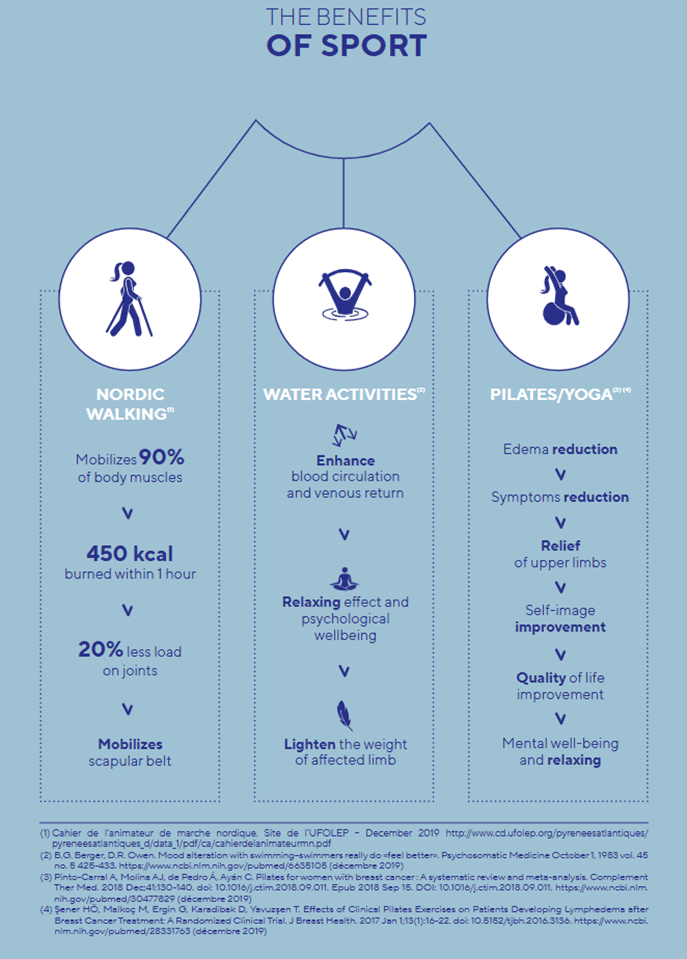What sports can I practice with lymphedema?
Lymphedema should not be a barrier to physical activity. On the contrary, sport has been shown to be beneficial in stimulating lymphatic circulation and improving the quality of life of those affected. All physical activities can be practised without any medical restrictions for lymphedema. There is no type of exercise that is not recommended as long as it is supervised and progressive(3,7).
Swimming, Nordic walking, yoga: find out which activities are recommended and what precautions you need to take to practice sport safely with your lymphedema.
Why is exercising beneficial for lymphedema?
Physical activity is strongly recommended for people with lymphedema. It tones the muscles, improving blood circulation and stimulating the lymphatic system(5).
The benefits of wearing compression garments when exercising have been scientifically demonstrated(2,3).
While exercising, blood circulation and lymphatic circulation are intensified. This might be painful in cases of lymphedema(2).
Compression garments are precisely designed to limit this pain. Worn during exercise, but also during the recovery phase, they limit the onset of pain and oedema(5).
A regular exercise programme helps to :
- Improve blood circulation and stimulate the lymphatic system(4).
- Promote supple skin(4).
- A positive impact on mental health: Exercise programs, especially those involving group activities or yoga, are highly beneficial. They improve patients' physical and emotional state. They also improve quality of life by reducing fatigue, pain and insomnia(4).
- Improves the symptoms associated with lymphedema, as well as limb function, physical condition and quality of life(4).
What kind of sports can I practice with lymphedema?
Several disciplines stand out for their effectiveness on lymphatic drainage, but no sport is discouraged (1). Swimming, at the top of the list, provides beneficial hydrostatic pressure. Cycling, has good muscle-pumping action, encourages lymph circulation. Nordic walking, with its use of poles, amplifies arm movement.
Gentle sports: walking, aquatic activities, pilates and yoga.

Tips for practising in complete safety
Listen to your body and adapt the intensity of your exercises. Start slowly and gradually increase the duration and frequency of your sessions(7).
Keep yourself well hydrated before, during and after exercise to encourage lymphatic circulation.
Remember to :
- Warm up properly.
- Alternate the muscle groups exercised.
After exercise, take the time to stretch. If you experience any unusual swelling or pain, stop exercising and consult your doctor.
- Protocole National de Diagnostic et de Soins (PNDS), Lymphoedème primaire, Haute Autorité de Santé, Février 2019
- Vignes, S. (2024, 10 octobre). TISSU ADIPEUX ET LYMPHOEDÈME SECONDAIRE DU MEMBRE SUPÉRIEUR. https://www.ks-mag.com/article/13922-tissu-adipeux-et-lymphoedeme-secondaire-du-membre-superieur
- Vignes, S. (2023). Traitements du lymphœdème (hors chirurgies et thérapies ciblées). La Presse Médicale Formation, 4(4), 369‑375. https://doi.org/10.1016/j.lpmfor.2023.07.016
- Executive Committee of the International Society of Lymphology. The diagnosis and treatment of peripheral lymphedema: 2020 Consensus Document of the International Society of Lymphology. Lymphology. 2020;53(1):3-19. PMID: 32521126.
- Compression therapy: A position document on compression bandaging, 2nd edition, ILF, 2020
- Fletcher J, Borthwick Y, Elwell R et al (2024) Practical issues in applying compression garments and wraps for management of lymphoedema. Wounds UK: UK Consensus Document. (s. d.). Dans wounds-uk.com. https://wounds-uk.com/wp-content/uploads/2024/10/MULTI24_CD_BLS_WUK_WEB-v3.pdf
- Isabelle Quéré, Quel est le bénéfice du sport dans le lymphœdème primaire ?, JMV-Journal de Médecine Vasculaire, Volume 49, Issue 1, 2024, Page 14, ISSN 2542-4513, https://doi.org/10.1016/j.jdmv.2024.01.076.


